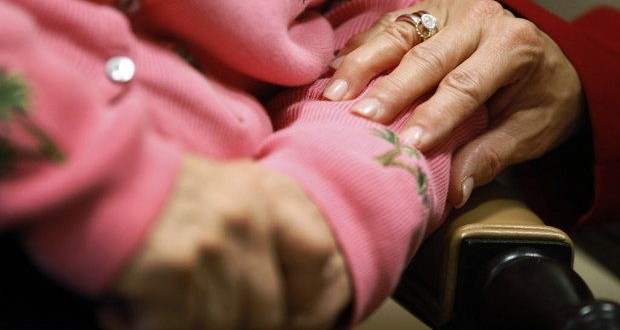HOUSTON -It’s a hard fact of life, and it’s harder for women than anyone else. 5 million Americans live with Alzheimer’s, two thirds of them, women. New numbers from the Alzheimer’s Association show that women 65 and over are nearly twice as likely to develop dementia and other Alzheimer’s related diseases than men.
“Through our role in the development of The Shriver Report: A Woman’s Nation Takes on Alzheimer’s in 2010, in conjunction with Maria Shriver, we know that women are the epicenter of Alzheimer’s disease, representing majority of both people with the disease and Alzheimer’s caregivers. Alzheimer’s Association Facts and Figures examines the impact of this unbalanced burden,” said Angela Geiger, chief strategy officer of the Alzheimer’s Association. “Well-deserved investments in breast cancer and other leading causes of death such as heart disease, stroke and HIV/AIDS have resulted in substantial decreases in death. Comparable investments are now needed to realize the same success with Alzheimer’s in preventing and treating the disease.”
Adding to women’s Alzheimer’s burden, there are 2.5 times as many women than men providing intensive “on- duty” care 24 hours for someone living with Alzheimer’s disease. Among caregivers who feel isolated, women are much more likely than men to link isolation with feeling depressed (17 percent of women vs. 2 percent of men).
The strain of caring for someone with Alzheimer’s is also felt in the workplace. Among caregivers who have been employed while they were also caregiving:
20 percent of women vs. 3 percent of men went from working full-time to working part-time while acting as a caregiver.
18 percent of women vs. 11 percent of men took a leave of absence.
11 percent of women vs. 5 percent of men gave up work entirely.
10 percent of women vs. 5 percent of men lost job benefits.
Human and Financial Toll of Alzheimer’s
There are more than 5 million Americans living with Alzheimer’s disease, including 3.2 million women and 200,000 people under the age of 65 with younger-onset Alzheimer’s disease, but Alzheimer’s has far reaching effects that can plague entire families. There are currently 15.5 million caregivers providing 17.7 billion hours of unpaid care in the U.S., often at the detriment of their own health. The physical and emotional impact of dementia caregiving resulted in an estimated $9.3 billion in increased healthcare costs for Alzheimer’s caregivers in 2013.
The total national cost of caring for people with Alzheimer’s and other dementias is projected to reach $214 billion this year, not including unpaid caregiving by family and friends valued at more than $220 billion. In 2014, the cost to Medicare and Medicaid of caring for those with Alzheimer’s and other dementias will reach a combined $150 billion with Medicare spending nearly $1 in every $5 on people with Alzheimer’s or another dementia.
These numbers are set to soar as the baby boomers continue to enter the age of greatest risk for Alzheimer’s disease. Unless something is done to change the course of the disease, there could be as many as 16 million Americans living with Alzheimer’s in 2050, at a cost of $1.2 trillion (in current dollars) to the nation. This dramatic rise includes a 500 percent increase in combined Medicare and Medicaid spending and a 400 percent increase in out- of-pocket spending. The country’s first-ever National Plan to Address Alzheimer’s Disease has a goal of preventing and effectively treating Alzheimer’s disease by 2025. Ensuring strong implementation of the National Alzheimer’s Plan, including adequately funding Alzheimer’s research, is the best way to avoid these staggering human and financial tolls.
Lack of Understanding of the Disease
Alzheimer’s disease is the sixth leading cause of death in the United States, yet it is still widely misunderstood and underreported. Nearly a quarter (24 percent) of both men and women agree with the mistaken belief that Alzheimer’s must run in their family for them to be at risk. When looking at certain ethnic groups, these numbers were even higher. A third of Latinos (33 percent) and almost half of Asians (45 percent) agreed with that incorrect statement.
“Despite being the nation’s biggest health threat, Alzheimer’s disease is still largely misunderstood. Everyone with a brain — male or female, family history or not — is at risk for Alzheimer’s,” said Geiger. “Age is the greatest risk factor for Alzheimer’s, and America is aging. As a nation, we must band together to protect our greatest asset, our brains.”
In 2010, the Alzheimer’s Association in partnership with Maria Shriver and The Shriver Report conducted a groundbreaking poll with the goal of exploring the compelling connection between Alzheimer’s disease and women. Data from that poll were published in The Shriver Report: A Woman’s Nation Takes on Alzheimer’s, which also included essays and reflections that gave personal perspectives to the poll’s numbers. For the first time, that report revealed not only the striking impact of the disease on individual lives, but also its especially strong effects on women — women living with the disease, as well as women who are caregivers, relatives, friends and loved ones of those directly affected.
Realizing the impact Alzheimer’s has on women — and the impact women can have when they work together — the Alzheimer’s Association is launching a national initiative this spring highlighting the power of women in the fight against this disease. To join the movement, visit www.alz.org/mybrain.
Press Releases/Canadajournal
 Canada Journal – News of the World Articles and videos to bring you the biggest Canadian news stories from across the country every day
Canada Journal – News of the World Articles and videos to bring you the biggest Canadian news stories from across the country every day



